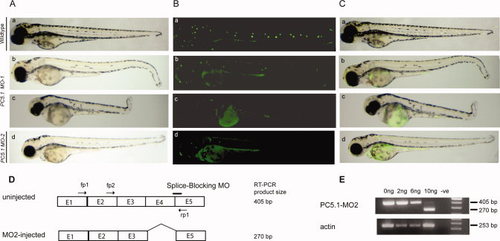
Morpholino-based translation inhibition disrupts formation of the lateral line. A: Phenotypic consequences of PC5.1 knockdown. MO-1 injected embryos (b, c) and MO-2 injected embryos (d) at 72 hpf displayed curved posterior body plan compared to wild type (a). B, C: Loss of functional neuromasts in PC5.1 Morphant detected by 4-Di-2-Asp staining. Comparison of WT (B, C: a) MO-1-injected embryos at 72hpf indicated either reduced (B, C: b) or complete absence (B,C: c) of posterior lateral line neuromasts. MO-2-injected embryos at 72 hpf showed either reduced (B,C: d) posterior lateral line neuromast or severe (data not shown) phenotypes. Knockdown of PC5.1 also resulted in circular swimming pattern and lack of a normal touch response. D: Altered splicing of zebrafish PC5.1 resulting from the use of morpholino, MO-2, to target a splice site boundary. The splice-blocking morpholino MO-2 overlaps the exon-intron boundary at the 32 splice junction of exon 4. The position of the forward and reverse primers used for diagnostic RT-PCR is indicated. The expected sizes of the RT-PCR products are indicated. E1 to E5 represents exon 1 to exon5 of PC5.1. E: RT-PCR of two 24hpf embryos either uninjected or injected with 2, 6, or 10 ng of MO-2. The 405-bp product of the normal-spliced PC5.1 fragment was detected in the uninjected embryos and in the 2- and 6-ng-injected embryos and to a much lesser extent in the 10-ng-injected embryos. The strong 270-bp product representing mRNA PC5.1 deleted from exon 4 was observed following RT-PCR of the embryos injected with 10 ng of MO-2. No template (-ve) and actin were used as negative and positive controls, respectively.
|

